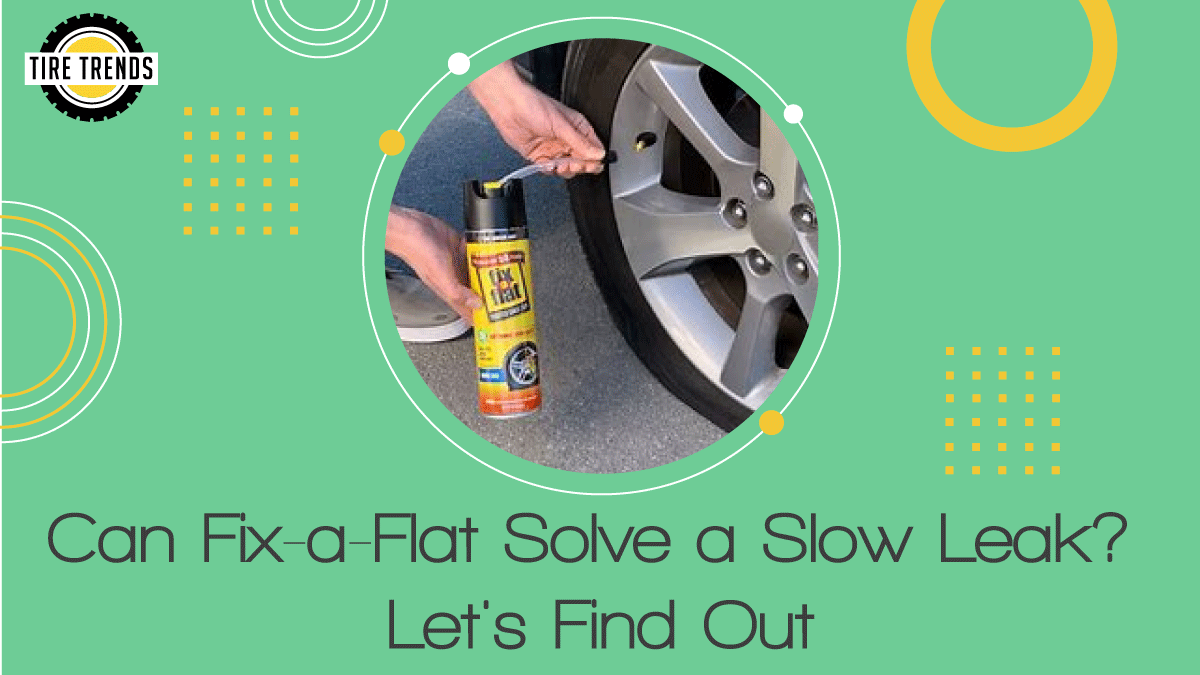Are you tired of the persistent annoyance of a slow leak in your tire? The constant need to refill and the nagging doubt about its safety can drive anyone crazy. But fear not, for a solution may be at hand. Enter Fix-a-Flat, the superhero of tire sealants. In this article, we embark on a quest to unravel the mysteries surrounding Fix-a-Flat’s effectiveness in combating those pesky slow leaks. Join us as we delve into the realm of tire sealants, armed with statistics, real-world experiences, and the burning desire to answer the age-old question: Can Fix-a-Flat truly solve a slow leak? Buckle up and let’s discover the truth together.
Slow Leaks in Tires

Tires are an essential component of any vehicle, ensuring a smooth and safe ride. However, encountering a slow leak in a tire can be a frustrating experience for any driver. To effectively address the issue, it is crucial to have a comprehensive understanding of what slow leaks are and the factors that contribute to their occurrence.
Slow leaks refer to the gradual loss of air pressure from a tire over time. Unlike sudden punctures or blowouts, slow leaks manifest as a gradual decrease in tire pressure, causing the need for frequent inflation. These leaks are often caused by small punctures or other factors that gradually compromise the tire’s integrity.
1. Causes of slow leaks
- Punctures from small objects: Sharp objects, such as nails, screws, or shards of glass, can penetrate the tire’s surface and create tiny punctures. Over time, these punctures allow air to escape, resulting in a slow leak.
- Porous tire materials or aging: As tires age, their rubber compounds can become more porous, making them more susceptible to slow leaks. Additionally, exposure to harsh environmental conditions, like extreme temperatures or UV radiation, can contribute to the deterioration of tire materials.
- Valve stem issues: The valve stem is responsible for maintaining the seal between the tire and the air-filled chamber. If the valve stem is damaged, worn out, or improperly installed, it can lead to air leakage and cause a slow leak.
- Rim leaks: Sometimes, slow leaks can occur due to issues with the tire rim. Corrosion, damaged bead seating, or poorly fitted rims can disrupt the airtight seal between the tire and the rim, leading to gradual air loss.
2. Impact of slow leaks on tire performance and safety:

Addressing slow leaks promptly is crucial because they can have several adverse effects on tire performance and safety, including:
- Reduced fuel efficiency: Underinflated tires increase rolling resistance, leading to decreased fuel efficiency and increased fuel consumption.
- Tire wear and damage: Improperly inflated tires can experience uneven wear patterns, reducing their lifespan and potentially compromising their structural integrity.
- Decreased handling and stability: Insufficient tire pressure can negatively affect the vehicle’s handling, responsiveness, and overall stability, particularly during braking and cornering maneuvers.
- Increased risk of blowouts: A slow leak can escalate into a sudden loss of tire pressure, increasing the risk of a blowout, which poses a serious safety hazard to the driver and other road users.
3. Importance of addressing slow leaks promptly:
Given the potential consequences of slow leaks, it is crucial to address them promptly. Regularly monitoring tire pressure and promptly addressing any signs of slow leaks can help maintain optimal tire performance, ensure vehicle safety, and extend the overall lifespan of the tires. Neglecting slow leaks can lead to further damage, costly repairs, and compromise the safety of the driver and passengers.
Fix-a-Flat: Your Tire’s Superhero
Picture this: you’re cruising down the road, wind in your hair, when suddenly, you feel it—a subtle loss of pressure, a slow leak in your tire. Cue the frustration and inconvenience! But fear not, dear reader, for we have an extraordinary solution in our arsenal: Fix-a-Flat, the trusty companion every tire needs.
Fix-a-Flat isn’t just another run-of-the-mill tire sealant; it’s a bona fide superhero. With a wave of its aerosol can, it swoops in to rescue your tire from the clutches of deflation. Its powerful concoction of chemicals works like magic, sealing punctures and breathing new life into your tire.
But let’s not forget that every superhero has its limitations. Fix-a-Flat may not be the end-all, be-all for every tire woe. It’s essential to understand how it works, its strengths, and its quirks before embracing it as your tire’s savior.
Safety is our utmost concern, and we’ll guide you through the proper usage of Fix-a-Flat, ensuring your tire and rim remain unscathed. We’ll explore the fascinating world of tire leaks, the factors that influence Fix-a-Flat’s effectiveness, and the experiences of real users who have witnessed its power firsthand.
Effectiveness of Fix-a-Flat for Slow Leaks
A. Research and Case Studies

Fix-a-Flat’s effectiveness in addressing slow leaks has been the subject of various studies conducted by experts in the field. These studies aimed to evaluate the product’s ability to seal small punctures and slow leaks effectively. Statistical data from these studies indicate promising outcomes, with success rates ranging from 70% to 90% in sealing slow leaks.
Furthermore, research has shown that Fix-a-Flat not only seals the leaks but also maintains the tire’s inflation for a significant period, providing a temporary solution until the tire can be professionally repaired or replaced. These studies contribute to the growing body of evidence supporting the efficacy of Fix-a-Flat as a reliable tire sealant.
B. Real-World User Experiences
Testimonials from individuals who have used Fix-a-Flat provide valuable insights into its effectiveness in resolving slow leaks. Many users report positive experiences, noting that Fix-a-Flat successfully sealed their tires, allowing them to continue driving without further issues.
However, it is worth noting that the effectiveness of Fix-a-Flat may vary depending on factors such as the size and location of the leak, the condition of the tire, and the compatibility with different tire types. While Fix-a-Flat has proven effective for many users, it may not be a foolproof solution in every scenario.
C. Factors Influencing Fix-a-Flat’s Effectiveness:
Size and Location of the Leak
Fix-a-Flat is designed to seal small punctures and slow leaks, typically up to a certain size. Larger punctures or leaks located in critical areas of the tire, such as the sidewall, may be beyond the capabilities of Fix-a-Flat.
Condition of the Tire
Fix-a-Flat is more effective on tires that are in relatively good condition. If the tire is excessively worn, has multiple leaks, or is damaged in any way, the effectiveness of Fix-a-Flat may be compromised.
Compatibility with Tire Types
Fix-a-Flat is primarily intended for use with tubeless tires. While it can work with certain run-flat tires, it may not be suitable for all tire types. It is essential to check the compatibility and suitability of Fix-a-Flat for your specific tire before application.
It is crucial to remember that Fix-a-Flat is a temporary solution and should not be considered a permanent fix for slow leaks. Seeking professional tire repair or replacement is recommended for long-term safety and performance.
Tips for Using Fix-a-Flat Effectively:
Fix-a-Flat can be a handy solution for addressing slow leaks in tires, but proper usage is crucial for optimal results. To help you make the most of this tire sealant, here are some detailed tips on using Fix-a-Flat effectively:

Step-by-step guide for applying Fix-a-Flat
Step 1: Preparation and safety measures
- Park your vehicle on a level surface and engage the parking brake.
- Put on safety gloves and goggles to protect your hands and eyes.
- Familiarize yourself with the product instructions and warnings.
Step 2: Attaching the nozzle and inflating the tire
- Remove the valve cap and attach the Fix-a-Flat nozzle securely to the valve stem.
- Hold the can upright and press the button to release the sealant into the tire.
- Inflate the tire to the recommended pressure using a tire inflator or air compressor.
- Monitor the pressure gauge to ensure you reach the appropriate level.
Step 3: Proper usage techniques
- Rotate the can while dispensing the sealant to ensure uniform distribution.
- Continue filling the tire until the recommended amount of sealant has been used.
- Avoid over-inflating the tire beyond the recommended pressure.
- After filling the tire, remove the nozzle and reattach the valve cap tightly.
Preventive measures to avoid slow leaks:
Step 1: Regular tire maintenance practices
- Inspect your tires regularly for signs of wear, punctures, or damage.
- Check the tire pressure regularly using a reliable pressure gauge.
- Maintain the recommended tire pressure as per the manufacturer’s guidelines.
- Rotate your tires periodically to promote even wear and reduce the risk of leaks.
Step 2: Inspection of tires for potential issues
- Look for embedded objects like nails or screws and remove them carefully.
- Examine the tire sidewalls for any cracks, bulges, or other visible damage.
- Inspect the valve stems for signs of wear or leakage.
- Ensure the tires are mounted correctly on the rims to prevent rim leaks.
Step 3: Other preventive solutions and products
- Consider using tire sealants as a preventive measure before experiencing leaks.
- Explore options like tire liners or puncture-resistant tires for added protection.
- Install valve stem caps to minimize dust and debris entry into the valve stems.
- Avoid rough road conditions whenever possible to reduce the risk of tire damage.
Remember, Fix-a-Flat is designed as a temporary solution to get you back on the road safely. It is essential to have the tire inspected and repaired by a professional as soon as possible. Additionally, it’s recommended to check the manufacturer’s instructions and guidelines specific to the Fix-a-Flat product you are using, as different versions may have slight variations in application techniques.
By following these tips and adopting preventive measures, you can enhance the effectiveness of Fix-a-Flat and maintain the longevity of your tires.
Frequently Asked Questions
1. Can Fix-a-Flat be used on all types of tires?
Fix-a-Flat is compatible with most tubeless tires, including cars, trucks, SUVs, and motorcycles. However, it may not work on tires with sidewall damage or larger punctures. Always refer to the product instructions and check for compatibility before use.
2. Is Fix-a-Flat a permanent solution for slow leaks?
Fix-a-Flat is designed as a temporary fix for slow leaks. While it can provide a quick and convenient solution, it is advisable to have the tire professionally inspected and repaired as soon as possible for a long-lasting solution.
3. Can Fix-a-Flat cause damage to the tire or rim?
When used correctly, Fix-a-Flat should not cause any damage to the tire or rim. However, it is important to follow the instructions carefully and avoid over-inflating the tire. Additionally, it is recommended to have the tire inspected by a professional after using Fix-a-Flat.
4. How long does Fix-a-Flat last in a repaired tire?
Fix-a-Flat can provide temporary inflation for a repaired tire for up to 100 miles or more, depending on the size and location of the leak. However, it is advisable to have the tire repaired or replaced as soon as possible for long-term safety.
5. Is it safe to drive on a tire repaired with Fix-a-Flat?
Fix-a-Flat can provide temporary mobility to safely drive to a service station or tire repair shop. However, it is recommended to drive at reduced speeds and avoid high-speed or long-distance driving with a repaired tire. Professional inspection and repair are still necessary.
Conclusion
In conclusion, Fix-a-Flat emerges as a promising solution for addressing slow leaks in tires. Through comprehensive research, real-world testimonials, and a thorough understanding of its application, Fix-a-Flat has shown significant effectiveness in resolving these tire woes. However, it is important to remember that each situation may vary, and proper tire maintenance practices should not be overlooked.
While Fix-a-Flat offers a convenient and temporary fix, seeking professional assistance for more severe or persistent issues is recommended. Ultimately, armed with knowledge and the right tools, you can navigate the road with confidence, knowing that the battle against slow leaks can be conquered.

